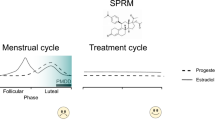Abstract
Kindling and impaired electroencephalophysiology have been suggested to play a role in the pathophysiology of premenstrual dysphoric disorder (PMDD). Levetiracetam is a novel antiepileptic drug which has shown strong anti-kindling activity in animal models of epilepsy. In this preliminary prospective study we examined the safety and efficacy of levetiracetam for the treatment of PMDD. One hundred twenty-three potential patients were prospectively screened to enroll seven patients into the open-label treatment phase of the study. PMDD was diagnosed per DSM-IV-TR criteria and two consecutive months of prospective ratings of Daily Record of Severity of Problems (DRSP). The Mini International Neuropsychiatric Interview (MINI) was used to exclude any co-morbid conditions. Levetiracetam was started at 250 mg qhs at the end of the first week of the follicular phase. Dosage was gradually increased up to 1,500 mg bid as tolerated or clinically effective. The treatment phase lasted 4 months. Response to treatment was evaluated by Clinical Global Impression (CGI) and DRSP scores. Six out of seven patients experienced a considerable decrease in their DRSP scores with levetiracetam, starting from the first treatment cycle. One patient dropped out of the study due to lack of efficacy after one cycle. Medication was fairly well tolerated. Improvements in food cravings and premenstrual headaches were also noted as unexpected benefits. Anticonvulsant medications, specifically levetiracetam, could be effective in the treatment of PMDD. Future double-blind, placebo controlled, randomized studies are warranted and should include larger number of patients.
Similar content being viewed by others
References
ACOG (2000) News release: ACOG issues guidelines on diagnosis and treatment of PMS
Andersch B, Wendestam C, Hahn L, Ohman R (1986) Premenstrual complaints. I. Prevalence of premenstrual symptoms in a Swedish urban population. J Psychosom Obstet Gynaecol 5:39–49
Blumer D (1997) Antidepressant and double antidepressant treatment for the affective disorder of epilepsy. J Clin Psychiatry 58(1):3–11
Blumer D (2000) Dysphoric disorders and paroxysmal affects: recognition and treatment of epilepsy-related psychiatric disorders. Harv Rev Psychiatry 8(1):8–17
Blumer D, Herzog AG, Himmelhoch J, Salgueiro CA, Ling FW (1998) To what extent do premenstrual and interictal dysphoric disorder overlap? Significance for therapy. J Affect Disord 48(2–3):215–225
Endicott J, Nee J, Harrison W (2006) Daily Record of Severity of Problems (DRSP): reliability and validity. Arch Womens Ment Health 9(1):41–49
Eriksson E (1999) Serotonin reuptake inhibitors for the treatment of premenstrual dysphoria. Int Clin Psychopharmacol 14(Suppl 2):S27–S33
Gangdev PS, Joshi VS, Karnik PR, Dias L, Das S (1991) Efficacy of carbamazepine in premenstrual syndromes. A report on four cases. J Assoc Phys India 39(5):419–420
Graze KK, Nee J, Endicott J (1990) Premenstrual depression predicts future major depressive disorder. Acta Psychiatr Scand 81(2):201–205
Halbreich U (2003) The etiology, biology, and evolving pathology of premenstrual syndromes. Psychoneuroendocrinology 28:55–99
Herzog A (1989) Perimenopausal depression: possible role of anomalous brain substrates. Brain Dysfunct 2:146–154
Himmelhoch JM (1984) Major mood disorders related to epileptic changes. In: Blumer D (ed) Psychiatric aspects of epilepsy. American Psychiatric Press, Washington DC, pp 271–294
Jacobsen FM (1993) Low-dose valproate: a new treatment for cyclothymia, mild rapid cycling disorders and premenstrual syndrome. J Clin Psychiatry 54(6):229–234
Johnson SR, McChesney C, Bean JA (1988) Epidemiology of premenstrual symptoms in a non-clinical sample. I. Prevalence, natural history and help-seeking behavior. J Reprod Med 33(4):340–346
Klitgaard H (2001) Levetiracetam: The preclinical profile of a new class of antiepileptic drugs? Epilepsia 42(Suppl 4):13–18
Loscher W, Honack D, Rundfeldt C (1998) Antiepileptogenic effects of the novel anticonvulsant levetiracetam (ucb L059) in the kindling model of temporal lobe epilepsy. J Pharmacol Exp Ther 284(2):474–479
Lynch BA, Lambeng N, Nocka K, Kensel-Hammes P, Bajjalieh SM, Matagne A, Fuks B (2004) The synaptic vesicle protein SV2A is the binding site for the antiepileptic drug levetiracetam. Proc Natl Acad Sci U S A 101(26):9861–9866
Merikangas KR, Foeldenyi M, Angst J (1993) The Zurich study. XIX. Patterns of menstrual disturbances in the community results of the Zurich cohort study. Eur Arch Psychiatry Clin Neurosci 243(1):23–32
Pearlstein TB (1995) Hormones and depression: what are the facts about premenstrual syndrome, menopause, and hormone replacement therapy? Am J Obstet Gynecol 173(2):646–653
Post RM (1992) Transduction of psychosocial stress into the neurobiology of recurrent affective disorder. Am J Psychiatry 149(8):999–1010
Post RM, Rubinow DR, Ballenger JC (1986) Conditioning and sensitization in the longitudinal course of affective illness. Br J Psychiatry 149:191–201
Ramcharan S, Love EJ, Fick GH, Goldfien A (1992) The epidemiology of premenstrual symptoms in a population based sample of 2650 urban women: attributable risk and risk factors. J Clin Epidemiol 45(4):377–392
Rivera-Tovar AD, Frank E (1990) Late luteal phase dysphoric disorder in young women. Am J Psychiatry 147(12):1634–1636
Steiner M, Judge R, Kumar R (1997) Serotonin re-uptake inhibitors in the treatment of premenstrual dysphoria: current state of knowledge. Int J Psychiatry Clin Pract 1:241–247
Yonkers KA, Halbreich U, Freeman E, Brown C, Endicott J, Frank E, Parry B, Pearlstein T, Severino S, Stout A, Stone A, Harrsion W (1997) Symptomatic improvement of premenstrual dysphoric disorder with Sertraline treatment. A randomized controlled trial. Sertraline Premenstrual Dysphoric Collaborative Study Group. JAMA 278(12):983–988
Acknowledgements
This study was supported by an Investigator Initiated Study Grant to Zerrin E. Kayatekin, MD from UCB, Inc. None of the authors are affiliated with UCB, Inc. nor have any financial ties.
We would like to thank our research coordinators Linda Crowe and Mark Mozzi; and Juliana Reiss, Psy.D. for the clinical support.
Author information
Authors and Affiliations
Corresponding author
Rights and permissions
About this article
Cite this article
Kayatekin, Z.E., Sabo, A.N. & Halbreich, U. Levetiracetam for treatment of premenstrual dysphoric disorder: A pilot, open-label study. Arch Womens Ment Health 11, 207–211 (2008). https://doi.org/10.1007/s00737-008-0014-9
Received:
Accepted:
Published:
Issue Date:
DOI: https://doi.org/10.1007/s00737-008-0014-9




